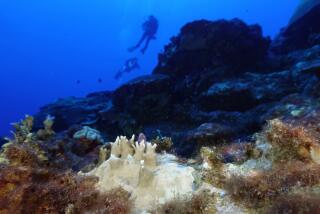Coral bleaching epidemic devastates reefs off South Florida
- Share via
Reporting from FORT LAUDERDALE, Fla. — Corals are turning chalk white and dying on reefs stretching from the Florida Keys to the Miami area, in what experts call one of the worst episodes in two decades of coral bleaching in Florida.
Under stress from unusually warm water, the corals are expelling the tiny bits of algae that give them their fiery streaks of red, orange or green and that provide the coral with nutrition.
Divers have reported tracts of corals that have lost their living tissue, leaving ghostly white skeletons. Bleaching leaves coral vulnerable to diseases that can be fatal, although some corals regain their color and survive.
Federal and state officials say the bleaching started this summer, as ocean temperatures peaked. The danger is expected to diminish as cooler weather arrives, but many coral communities, which support a vast range of fish, crabs and other marine life, may not be able to recover.
“It’s significant impact, and it’s permanent,” said Margaret Miller, ecologist with the National Marine Fisheries Service Southeast Fisheries Science Center. “Corals do not grow back very effectively. So that’s a permanent loss to our coral community. It just becomes rock.”
The corals form the only major reef tract in the continental United States and support fishing, diving and snorkeling. Reporting the bleached and dead corals are scientists from government agencies and universities, as well as volunteer divers, in a system coordinated by the Florida Department of Environmental Protection.
The department says the most bleaching has been seen in the Florida Keys, Miami-Dade County and Broward County, although some reports have also come in from Palm Beach County about 40 miles north of Miami.
Brian Walker, research scientist at Nova Southeastern University’s Halmos College of Natural Sciences and Oceanography, said the hardest-hit species include pillar, maze, star and staghorn corals.
These include corals off Broward and Miami-Dade counties that had survived 200 or 300 years. Scientists have found that some of these old corals have lost nearly half of their living tissue.
“These corals are very important because they have proven to be quite resilient, withstanding everything over the last couple hundred years,” Walker said. “Understanding how these resilient corals respond to present environmental conditions informs us of how the environment has changed. The fact that they are dying now after living hundreds of years may indicate that their surroundings are much more stressful than ever before.”
The sick corals off the South Florida coast are part of a worldwide bleaching outbreak that includes the coral reefs of Hawaii and other Pacific islands and is projected to reach Indonesia, the Philippines and Australia.
The last global coral bleaching event occurred in 1997 and 1998, when 15% to 20% of the world’s coral reefs were lost, the Department of Environmental Protection said in a statement.
Asked to describe what he’s seen, Walker said, “Many white colonies, some diseased colonies, and many corals that have recently died. These are identifiable by exposed fresh skeleton without any tissue or bare colonies covered with a layer of turf algae. Some sites appear to have over 50% of the colonies affected.”
Bleaching episodes have increased in duration and severity in the last few decades, according to the National Marine Fisheries Service. Miller said climate change is likely to be a long-term factor in increasing the number of bleaching episodes, although it would be difficult to tie any particular episode to global warming.
This year, for example, there is a strong El Niño, the periodic warming of the eastern Pacific Ocean along the equator, which is a factor in the bleaching taking place around the world, she said.
More to Read
Sign up for Essential California
The most important California stories and recommendations in your inbox every morning.
You may occasionally receive promotional content from the Los Angeles Times.










